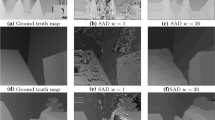Abstract
In this article, new local matching measures, based on fuzzy similarity, for stereo matching of color images are proposed and evaluated. By formulating the individual similarity between a pair of pixels as a conjunction of the similarities of the respective color components, the field programmable gate array implementation problem becomes more computationally tractable, since the word-length of the numbers carrying the similarity information can be reduced compared to standard techniques (Sum of absolute differences and Sum of squared differences). It is also shown that combining information about color and local image structure (horizontal gradient component) in the matching measure and using a multi-scale measure is advantageous compared to using standard measures, in terms of percentage of correct matches and MSE for the erroneous matches. However, these improvements come at the prize of more complex implementations. Since the techniques are window-based, they share the typical drawbacks associated with other techniques of this type. This is expected, since the focus is on developing new local matching measure without addressing issues like post-processing of the resulting disparity maps. The techniques have been tested on two stereo color image pairs.
Similar content being viewed by others
References
Darabiha A, Rose J, MacLean WJ (2003) Video-rate stereo depth measurement on programmable hardware. In: Proceedings of IEEE conference on computer vision and pattern recognition, vol 1, pp 203–210, Madison, WI
Fleet DJ (1994) Disparity from local weighted phase-correlation. In: Proceedings of IEEE international conference on systems, man and cybernetics, San Antonio, pp 48–54
Hirschmüller H (2001) Improvements in real-time correlation-based stereo vision. In: Proceedings of IEEE workshop on stereo and multi-baseline vision, pp 141–148, Kauai, HI
Kalaykov I, Tolt G (2003) Real-time image noise cancellation based on fuzzy similarity. In: Nachtegael M et al (eds) Fuzzy filters for image processing. Springer, Berlin Heidelberg New York, ISBN- 3-540-00465-3, pp 54–71
Murray D, Little J (2000) Using real-time stereo vision for mobile robot navigation. Auton Robots 8(2):161–171
Scharstein D, Szeliski R (2002) A taxonomy and evaluation of dense two-frame stereo correspondence algorithms. Int J Comput Vis 47:7–42
Tolt G (2003) Determining edgeness using homogeneity of templates. In: Proceedings of IEEE international conference on fuzzy systems. St. Louis, Missouri, pp 950–954
Tolt G, Kalaykov I (2001) Fuzzy-similarity-based noise cancellation for real-time image processing. In: Proceedings of IEEE international conference on fuzzy systems, vol 1. Melbourne, Australia
Veksler O (2003) Fast variable window for stereo correspondence using integral images. In: Proceedings of IEEE conference on computer vision and pattern recognition, vol 1, pp 556–561
Author information
Authors and Affiliations
Corresponding author
Rights and permissions
About this article
Cite this article
Tolt, G., Kalaykov, I. Measures Based on Fuzzy Similarity for Stereo Matching of Color Images. Soft Comput 10, 1117–1126 (2006). https://doi.org/10.1007/s00500-005-0034-6
Published:
Issue Date:
DOI: https://doi.org/10.1007/s00500-005-0034-6




